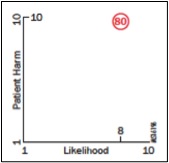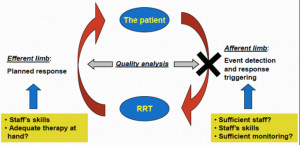Two Studies Presented at ATS 2017 Underscore Need for Better Monitoring and Earlier Treatment of Elderly Patients to Reduce Respiratory Compromise
Vienna, VA – May 21, 2017 – The Respiratory Compromise Institute (RCI) today announced results of two studies evaluating mortality associated with respiratory compromise in hospitalized Medicare patients. The abstracts were presented at ATS 2017, the annual meeting of the American Thoracic Society, which is taking place in Washington, D.C., May 19-24.
Respiratory compromise is a deterioration of respiratory function that poses a high risk of life-threatening respiratory failure. Respiratory failure is the second leading avoidable patient safety issue.1 It is one of the top five conditions leading to increasing hospital costs2 and the third most rapidly increasing hospital inpatient cost in the United States.3 General care floor patients with respiratory compromise are 29 times more likely to die. The ECRI Institute recently identified opioid administration and monitoring in acute care as a top ten patient safety concern.
The studies are the first retrospective analyses of mortality associated with respiratory failure based on Medicare administrative claims data for inpatient admissions to short-term acute care hospitals. The study was conducted for the time period between January 1, 2012 and December 31, 2014. Based on a review of the Medicare database of hospital admissions, an annual estimate of at least 111,020 Medicare beneficiaries suffer from respiratory compromise.
The first study (Abstract #A1895) evaluated medical records for patients who developed respiratory failure after hospitalization for medical (n =16,653) or surgical (n =13,895) inpatient stays. The average age for the medical and surgical groups was 73.2 and 72.4 years of age, respectively.
In-hospital mortality was greater for medical compared with surgical patients (32.7% vs. 25.1%, p < 0.0001). Mortality during the 30 days post-discharge was also greater for medical compared with surgical patients (15.3% vs. 9.8%, p < 0.0001). In both medical and surgical groups, hospital mortality was considerably worse when acute kidney failure occurred during the hospitalization (p < 0.0001). While both groups had a high rate of intubation, medical patients had more non-invasive mechanical ventilation compared with surgical patients (33% vs. 14%, p < 0.001). The majority of patients in both groups showed evidence of a prior hospitalization within the year previous to the index admission used in this analysis. Medical patients were more likely to have been in a skilled nursing facility (26% vs. 16%, p < 0.001).
“While these data verify that respiratory compromise is a significant safety issue in the hospital setting, particularly among this elderly population, we know that it can be identified in most cases and by doing so, acute respiratory failure may be prevented,” said Sidney Braman, MD, Professor in the Pulmonary, Critical Care and Sleep Medicine Division of the Icahn School of Medicine at Mount Sinai – National Jewish Health Respiratory Institute and lead author of the study. “The results support the need for improved monitoring and intervention strategies to reduce the risk of respiratory compromise and improve outcomes.”
The other study (Abstract #A1893) compared Medicare patients who had hospital-acquired respiratory compromise (HARC) (n=16,653, average age 73.2 years) with patients who had respiratory failure diagnosed at the time of hospital admission (n = 18,503, average age = 70.8 years). In-hospital mortality was 32.7% in patients with HARC versus 27.8% in those patients with respiratory failure diagnosed at time of hospital admission (p < 0.0001). Mortality at 30 days post hospital discharge was also significantly different (HARC: 15.3% and respiratory failure at time of hospital admission: 12.9%, p = 0.0001). Patients with HARC had high rates of concomitant diseases (chronic heart failure (45%), hypertension (38%), atrial fibrillation (35%), acute kidney failure (36%), pneumonia (31%) and septicemia (26%).
“This analysis shows that Medicare patients who are recognized as having respiratory failure after hospitalization have significantly higher mortality than patients diagnosed as having respiratory failure at time of hospital admission,” said James P. Lamberti, MD, Professor of Medicine at Virginia Commonwealth University Inova Campus and Medical Director of Respiratory Care Services at Inova Fairfax Hospital. “The fact that 48% of patients who develop HARC either die in the hospital or within 30 days of hospital discharge demonstrates the urgent need for further study of HARC. Since this study utilized Medicare administrative claims data, a prospective observation study is required to understand the time course and progression of respiratory compromise after hospital admission. Better clinical data will hopefully allow development of strategies for early identification and intervention in the continuum of respiratory compromise to respiratory failure within the hospital. Further study will also identify the role of palliative care in this group of patients with a very high risk of death.”
Phillip Porte, Executive Director of RCI, commented: “Collectively, the study results suggest the urgent need for further study of hospital acquired respiratory compromise, with a focus on early identification and preventative strategies to reduce respiratory compromise. While data on respiratory compromise are limited, these two studies help establish a foundation of the incidence among elderly patients in the hospital setting and provide a compelling call to action to improve our understanding to prevent and manage respiratory compromise to mitigate progression to more debilitating forms of respiratory dysfunction.”
About Respiratory Compromise
Respiratory compromise, which includes respiratory distress, insufficiency, failure and arrest, can occur across numerous clinical scenarios. For example, respiratory compromise may appear post-operatively or may be drug-induced by the delivery of a sedative, opioid, or analgesic to patients who were not properly assessed or properly monitored.
According to the U.S. Department of Health & Human Services, Agency for Healthcare Research and Quality, respiratory compromise is the third most rapidly increasing hospital inpatient cost in the United States, with $7.8 billion spent on respiratory compromise in U.S. hospitals in 2007. Respiratory compromise increases patient mortality rates by over 30 percent and hospital and ICU stays by almost 50 percent. RCI defines respiratory compromise as a state in which there is a high likelihood of decompensation into respiratory insufficiency, respiratory failure or death that could be prevented or mitigated through specific interventions (enhanced monitoring and/or therapies).
About Respiratory Compromise Institute
The Respiratory Compromise Institute brings together a broad-based coalition of organizations, companies, and individuals dedicated to reducing—and eventually eliminating—preventable adverse events and deaths due to respiratory compromise.
Media Contact
Erich Sandoval
Lazar Partners Ltd.
Tel: +1 917-497-2867
Email: esandoval@lazarpartners.com






